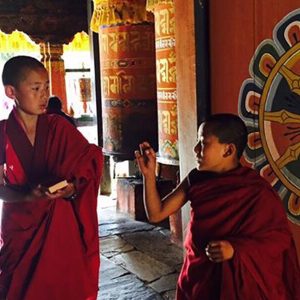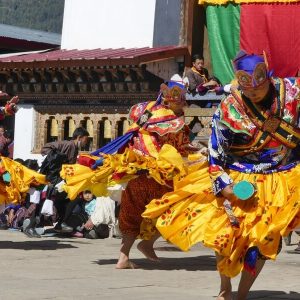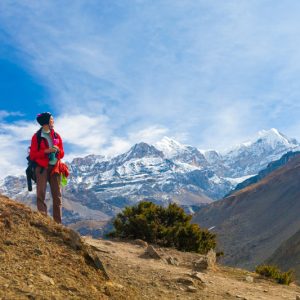Discover the Buddhist lifestyle and monastic rhythms in Bhutan’s sacred heartlands
Introduction: Who Becomes a Monk in Bhutan?

In Bhutan, monastic life is not reserved for a spiritual elite — it’s an accessible and respected path that many families consider for their sons. Boys as young as 6 or 7 years old may enter monastic life, often with the blessing (or encouragement) of their families, especially in rural areas.
Some come from a lineage of monks or lamas, while others are offered to the monastery as a form of spiritual merit. The process is simple but meaningful: the child joins a monastery as a novice monk (trulku or gomchen), receives a monastic name, and begins a life of study, prayer, and discipline under the guidance of senior monks. Entry into full monkhood typically occurs after adolescence, following years of training and commitment.
While some remain monks for life, others may return to lay life — a choice respected within Bhutanese society. Monasticism is not seen as a prison but a formative path open to change.
Dawn: The Sound of Silence and Prayer
Around 4:30 AM, monks rise to the soft ringing of bells or the call of a senior.
The air is still and cold, the sky deep blue. Wrapped in their maroon robes, monks gather in the temple for the first session of prayers and chants, often lasting two hours.
These are not mere rituals — they are a daily reaffirmation of the Buddhist path: cultivating compassion, awareness, and letting go of ego.
Morning: Chores and Buddhist Education
After prayers, the monastery becomes a blend of practical work and intellectual pursuit. Novices sweep the temple courtyards, refill butter lamps, or help prepare the communal meal.
By 9:00 AM, it’s time for formal study. The education of monks in Bhutan is rigorous and highly structured. Depending on age and level, the curriculum may include:
- Classical Tibetan (Choekey) – the liturgical language of Bhutanese Buddhism
- Buddhist philosophy – especially Madhyamaka (the Middle Way), Abhidharma (psychology), and Vinaya (monastic code)
- Ritual practice and liturgy – learning to chant, perform pujas (rituals), and handle sacred instruments
- Logic and debate – lively verbal sparring that trains clarity of thought
- Meditation techniques – both calm-abiding (shamatha) and insight (vipassana)
- Calligraphy and sacred art – in some institutions
Some advanced monks pursue degrees in Buddhist philosophy through monastic universities such as the Institute of Language and Culture Studies (ILCS) or the Shedras of Tango, Cheri, or Punakha.
Meals and Monastic Sustenance
Monks typically eat two main meals: one in the morning after prayers, and one at noon. The food is simple, largely vegetarian, and locally sourced: rice, lentils, vegetables, chili-based dishes like ema datshi, and butter tea (suja).
But how is the monastery fed?
- Offerings from the lay community are a major source. Families often bring bags of rice, vegetables, or money to support the monks as acts of merit.
- Small monastery farms or kitchen gardens grow vegetables or herbs.
- In larger monasteries, government support or spiritual patrons may help fund daily needs.
- Some monks engage in craftwork or spiritual services (like astrology readings or rituals) that generate donations.
Money is not used personally — it is pooled and managed by the monastery for collective needs.
Afternoon: Practice, Study, and Community Rituals
After lunch and a short rest, monks return to their texts, participate in group meditation, or conduct rituals for the community. A village family may have requested a blessing for a sick relative or a new house. These small ceremonies tie the monastic life to the everyday reality of Bhutanese society.
Late afternoon often includes more chanting, philosophical discussions, or ritual dance practice in preparation for local festivals (tshechus).
Evening: Silence and Self-Reflection
By 7:00 PM, the monastery quiets. A light evening drink or snack is served, and monks retire to their quarters. Some engage in silent meditation or mantra recitation. Others revise their studies by candlelight.
There is no phone, no TV, no social media — just stillness.
How to Experience Monastic Life in Bhutan as a Visitor

Life in a Bhutanese monastery is not easy — it demands discipline, humility, and commitment. But it also offers peace, purpose, and a deep connection to values that transcend materialism.
For travelers in search of more than landscapes or temples, spiritual travel in Bhutan offers something rare: the opportunity to witness, and perhaps glimpse for oneself, a life lived with intention:
- Retreats and short stays in temples like Chumphu Ney or monasteries near Paro, Thimphu, and Bumthang
- Silent meditation retreats guided by lamas or teachers
- Festival visits, where you can witness the vibrant connection between monks and local communities through sacred dances and rituals
- Private blessings or teachings, often available upon request through local guides
These experiences allow travelers to connect with Bhutan’s deep spiritual roots — not as tourists, but as respectful guests.
Contact us today to plan your custom spiritual journey in Bhutan!
FAQ: Understanding Bhutanese Monastic Life
What are things monks must never do?
- Break the Vinaya (monastic code), which prohibits killing, stealing, lying, sexual misconduct, and intoxication (drugs & alcohol)
- Accumulate personal wealth or use money for individual pleasure
- Engage in romantic relationships
- Disrespect elders, teachers, or sacred texts
What is their relationship with local communities?
Monks play vital social roles:
- Leading rituals for birth, death, and marriage
- Offering blessings, protection mantras, and astrological guidance
- Acting as spiritual counselors
In return, communities support them with food, offerings, and respect.
How do monks view money and sustenance?
Monks renounce personal ownership. Their needs — robes, food, shelter — are met by the monastery through community donations, spiritual services, or state support. Generosity from laypeople is seen as a sacred exchange that builds merit.
What about the family life of a monk?
While monks leave their biological families behind, they join a spiritual brotherhood. For young novices, elder monks become mentors and caregivers. Monks may occasionally visit family or perform rituals for them, but their central loyalty is to the Dharma (the Buddhist path).
Do Buddhist nuns exist in Bhutan?
Yes, Bhutan has a growing community of female monastics (anim). Though historically fewer in number and less publicly visible than monks, nuns play an increasingly important role in Bhutan’s spiritual landscape.
Do nuns receive the same education as monks?
This is changing. In the past, educational opportunities were limited, but today many nunneries offer:
- Classical Tibetan and Buddhist philosophy
- Ritual practice and meditation training
- Debate and logic in advanced settings
- Literacy and life skills (e.g. sewing, first aid)
Efforts by NGOs and royal initiatives (notably by the Queen Mother) have strengthened support for female monastic education in recent years.













